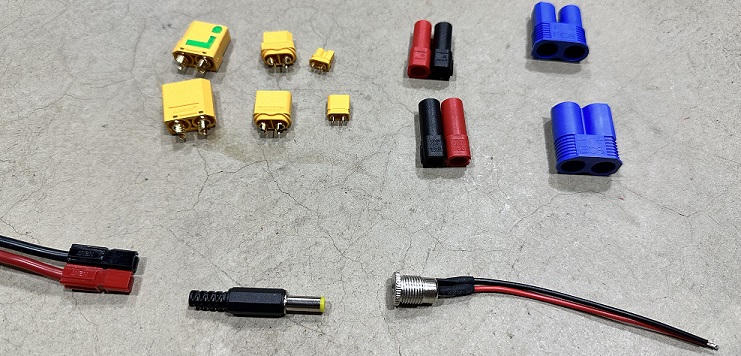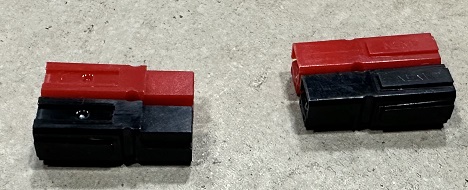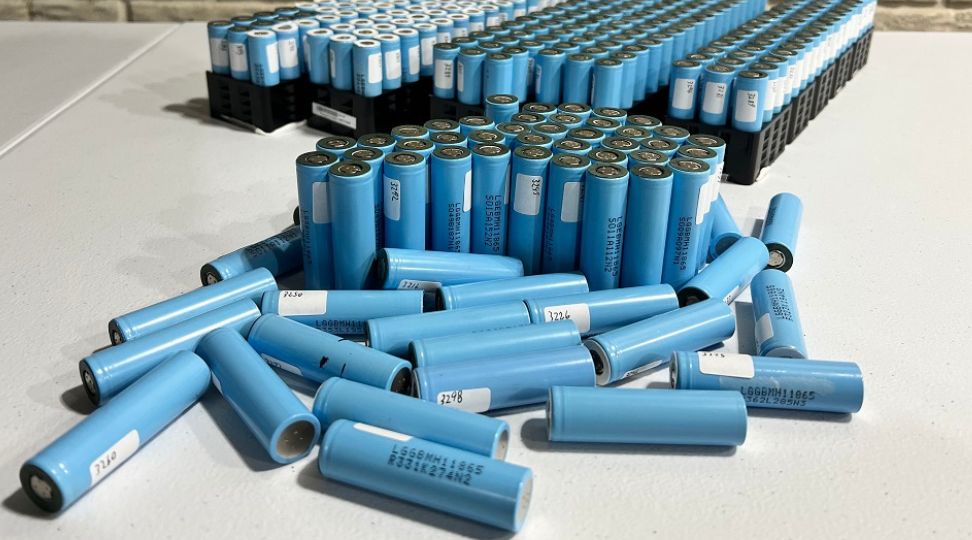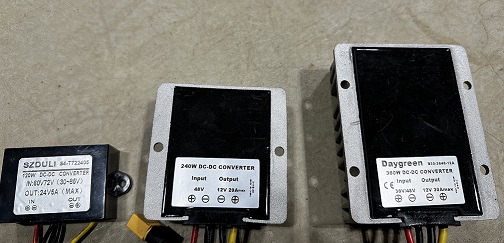
Battery Connector Types
Table of Contents
Battery connectors play a crucial role in powering a wide range of devices and applications. After all, you can't use a battery if you have no way to connect it to anything. Sure, it could always be soldered directly, but that’s not a very practical way to manufacture things. There are a ton of different kinds of battery connectors, and they all have their own unique advantages for a given application.
Some of the more common types of battery connectors include barrel jack connectors, XT connectors (XT30, XT60, XT90), Deans (T-plug) connectors, JST connectors, EC3/EC5 connectors, Traxxas connectors, Anderson Powerpole connectors, banana connectors, and bullet connectors.
Barrel jack connectors are often used for low-voltage and/or low-current DC power applications, such as connecting power adapters to electronic devices. XT connectors, available in different sizes, are widely used in the RC hobby industry for applications ranging from small drones to high-power electric bikes. Deans connectors are known for their low resistance and compact size, making them ideal for RC vehicles. JST connectors are commonly used in low-current applications, such as connecting batteries to small electronics. EC3/EC5 connectors are designed for high-current RC applications, while Traxxas connectors are popular for their ease of use in RC vehicles.
Anderson Powerpole connectors are modular connectors used in RC vehicles, ham radios, and emergency power supplies. Banana connectors are used in test equipment and audio applications, and bullet connectors provide simple, cylindrical connections for RC vehicles and power distribution. Each connector serves a specific purpose, ensuring efficient and reliable power transfer in various applications.
In this article, we will discuss the different types of battery connectors, their advantages and disadvantages, and the applications they are best suited for. We will also provide some tips on how to choose the right connector for your next DIY lithium battery build.
XT Series Battery Connectors
XT connectors are a family of power connectors that have become a go-to choice for many people working with battery-powered devices. They come in different sizes, each designed to handle a specific range of current. The most common types you'll come across are XT30, XT60, and XT90 connectors. Each one has its own unique features and best use cases.
XT30 Connectors:
- Ampacity: Up to 30 amps
- Applications: Small drones, RC vehicles, and low-current devices
- Features: The XT30 connector is a compact and lightweight connector designed for low-current applications. Its small form factor makes it ideal for use in devices where space is limited, and its secure connection ensures reliable power transfer.
XT30 connectors are super tiny and are perfect for small-scale projects that need a reliable power connection without taking up too much space. They're rated to handle up to 30 amps of current, which makes them a great fit for small drones, RC cars, and other compact devices. If you're building a mini quadcopter or a portable gadget, XT30 connectors might be just what you need!
XT60 Connectors:
- Ampacity: Up to 60 amps
- Applications: Drones, RC cars, and medium-power devices
- Features: The XT60 connector is widely used in the RC hobby industry and is suitable for medium-current applications. It provides a secure connection and is known for its durability and ability to handle higher current loads.
Next up the line, we have XT60 connectors. These are the workhorses of the XT family. They can handle up to 60 amps of current, making them ideal for medium-power applications. You'll often find XT60 connectors in larger drones, RC airplanes, and even on some e-bike batteries. They're super versatile and provide a secure connection, so you can trust them to keep your devices powered up and running smoothly. If you're working on an RC project that needs a bit more "oomph," XT60 connectors are a fantastic choice.
XT90 Connectors:
- Ampacity: Up to 90 amps
- Applications: High-power RC vehicles and devices with high current requirements
- Features: The XT90 connector is designed for high-current applications and is commonly used in larger RC vehicles and electric bikes. Its robust construction ensures a secure connection under demanding conditions.
Last but not least (actually most), we have XT90 connectors. These connectors are designed for high-current applications and can handle up to 90 amps. They're commonly used in larger RC vehicles, electric bikes, and other high-power devices. If you're building an off-road RC monster truck or an e-bike that can tackle steep hills, XT90 connectors are the way to go. They're robust and reliable, so you can focus on enjoying the ride without worrying about power interruptions.
Deans (T-Plug) RC Connectors
Deans connectors, also known as T-plugs, are a popular choice among RC enthusiasts and tech hobbyists. These connectors are loved for their low electrical resistance, which means efficient power transfer from your battery to your device. Plus, they're compact and lightweight, so they won't add bulk to your projects.
The design of Deans connectors is simple and effective. They consist of a male and female component that fit together securely, reducing the risk of accidental disconnections—crucial for RC racing and drone flying.
You'll often find Deans connectors in RC vehicles like cars, trucks, boats, and planes. They're perfect for applications where performance is key, and they're also used in custom electronics, robotics, and portable power systems. Just keep in mind that they're best for moderate current loads, typically up to around 60 amps.
- Ampacity: Up to 60 amps (general range)
- Applications: RC vehicles, devices with low resistance requirements
- Features: Deans connectors, also known as T-plugs, are known for their low resistance and compact size. These connectors provide a solid electrical connection and are commonly used in RC vehicles where performance optimization is desired.
Anderson Powerpole Connectors
Anderson Powerpole connectors are versatile power connectors known for their durability and ability to handle high current loads. With a genderless housing design, these connectors allow for quick assembly and are favored by hobbyists, professionals, and emergency responders.
A key feature of Anderson Powerpole connectors is their modularity. The flat, interlocking housings can be assembled into various configurations, enabling users to create custom connector arrangements. This flexibility is ideal for applications ranging from simple single-pole connections to complex power distribution.
These connectors are widely used in RC vehicles, ham radio equipment, DIY powerwalls, solar energy systems, and electric vehicles. Available in different sizes and current ratings, Anderson Powerpole connectors offer color-coded housings and silver-plated copper contacts for reliable power transfer.
- Ampacity: Up to 180 amps (general range)
- Applications: RC vehicles, ham radio, emergency power supplies
- Features: Anderson Powerpole connectors are modular connectors that can be customized to suit specific needs. They are used in a wide range of applications and are known for their durability, versatility, and ability to handle high current loads.
Barrel Jack Low Voltage Connectors
Barrel jack connectors are a common type of power connector used in low-voltage DC power applications. These connectors are cylindrical in shape and consist of a male plug and a corresponding female jack. The male plug is typically found on power adapters, while the female jack is often integrated into electronic devices.
One of the key features of barrel jack connectors is their simplicity. The connectors are easy to use and provide a straightforward way to connect power adapters to electronic devices. The male plug is simply inserted into the female jack to establish a secure electrical connection. This plug-and-play design makes barrel jack connectors a popular choice for a wide range of consumer electronics.
Barrel jack connectors come in various sizes, with different inner and outer diameters. It's important to match the size of the male plug with the size of the female jack to ensure a proper fit. Common applications for barrel jack connectors include powering laptops, routers, external hard drives, LED lights, and other low-voltage devices.
Barrel jack connectors are great but they aren’t perfect. They are typically designed for low-current applications and may not be suitable for high-power devices. Additionally, the connection may become loose over time, leading to intermittent power issues.
- Ampacity: Up to 5 amps (general range)
- Applications: Low-voltage DC power applications, power adapters, electronic devices, lithium battery chargers
- Features: Barrel jack connectors are cylindrical connectors commonly used for low-voltage DC power applications. They are simple to use and provide a reliable connection for low-current devices such as power adapters and electronic equipment.
JST Balance Lead Connectors
JST connectors are a versatile family of compact electrical connectors developed by Japan Solderless Terminal (JST). Commonly used in low-current applications where space is limited, JST connectors consist of a male plug and a female receptacle with a locking mechanism for a stable connection. They are often used to connect batteries to circuit boards and electronic components.
Various series of JST connectors exist, each with different specifications, pin counts, and pitch (distance between pins). Popular series include JST-PH, used in battery connections for drones and RC vehicles, and JST-XH, used for balance charging lithium-polymer (LiPo) batteries. These also may be familiar to those who have installed a BMS before as they are commonly used for BMS balance leads.
JST connectors are widely used in consumer electronics, automotive, robotics, and aerospace industries. They are found in devices like smartphones, cameras, and medical equipment. Their compact size and reliable performance make them ideal for applications with limited space.
- Ampacity: Up to 15 amps (general range)
- Applications: Low-current applications, batteries for small electronic devices
- Features: JST connectors are a family of connectors that come in various sizes and configurations. They are versatile and compact, making them ideal for low-current applications and devices with limited space.
EC3/EC5/EC8 RC and PEV Connectors
EC3, EC5, and EC8 connectors are types of power connectors commonly used in high-current applications, particularly in the remote-controlled (RC) hobby industry. These connectors are known for their ability to handle high current loads while providing a secure and efficient electrical connection.
EC3 connectors are rated to handle current loads of up to 60 amps, making them suitable for medium-power RC vehicles, drones, and other devices with moderate power requirements. EC5 connectors, on the other hand, are designed for even higher current loads, with a rating of up to 120 amps. EC8 connectors can handle even higher amperage ratings of 240A! This makes them ideal for larger and more powerful RC vehicles, electric bikes, and other high-power applications.
EC3, EC5, and EC8 connectors feature a blue, cylindrical housing and consist of a male plug and a corresponding female receptacle. The connectors are designed with gold-plated bullet-style contacts that ensure low resistance and efficient power transfer. The connectors also have a tight-fitting design that helps prevent accidental disconnections during use.
- Ampacity: Up to 60 amps (EC3), up to 120 amps (EC5), up to 240 amps (EC8)
- Applications: RC vehicles, high-current devices
- Features: EC3, EC5, and EC8 connectors are used in high-current applications and provide a secure and efficient connection. EC3 connectors are suitable for medium-current loads, while EC5 connectors are designed for higher-current loads and EC8 connectors for very high-current loads. All three connectors are commonly used in RC vehicles and other devices that require high power transfer.
Banana Low Amperage Connectors
Banana connectors are a super popular type of single-wire electrical connector that stands out for its simplicity, ease of use, and versatility. They get their name from their distinctive banana-like shape, as they are designed with a male plug that features a cylindrical metal pin along with a spring-like structure.
The male end of the plug fits snugly and securely when inserted into the female jack. The reliable electrical connection, combined with the ability to easily and quickly insert and remove the connectors, makes them a popular choice in many applications.
In test equipment and in labs, banana connectors are used to connect things like multimeters, oscilloscopes, power supplies, electronic circuits, and other components.
You can also find banana connectors in audio applications where they are used to connect speakers to amps, etc. These connectors are simple and reliable, so they are often the preferred choice for audio enthusiasts.
- Ampacity: Up to 15 amps (general range)
- Applications: Test equipment, audio applications, some RC applications
- Features: Banana connectors are single-wire connectors commonly used in testing and prototyping environments. They are also used in audio applications and some RC scenarios. Banana connectors are known for their simplicity and ease of use, making them a popular choice for establishing quick and reliable connections.
Bullet RC Battery Connectors
Bullet connectors are a type of electrical connector known for their simple and cylindrical design. They are commonly used to connect wires in a wide range of applications, including remote-controlled (RC) vehicles, power distribution, and electronic projects. Bullet connectors are valued for their ease of use, ability to be quickly disconnected and reconnected, and suitability for various current loads.
A bullet connector consists of a male plug and a corresponding female receptacle. The male plug is shaped like a cylindrical bullet, while the female receptacle has a tubular shape that matches the diameter of the male plug. When the male plug is inserted into the female receptacle, a secure electrical connection is established. The connectors are often color-coded or keyed to ensure proper polarity alignment.
Bullet connectors are available in different diameters, with larger bullet connectors capable of handling higher current loads. This makes them suitable for applications with varying power requirements.
In the RC hobby industry, bullet connectors are frequently used to connect batteries to electronic speed controllers (ESCs) and motors. They are also used in wire-to-wire connections where a secure yet easily detachable connection is desired. The simplicity of bullet connectors makes them a popular choice for hobbyists and DIY enthusiasts.
Bullet connectors are also used in power distribution systems, custom electronics, and automotive applications. Their straightforward design allows for quick assembly and disassembly, making them ideal for applications where frequent changes to the wiring configuration may be necessary.
- Ampacity: Up to 80 amps (general range)
- Applications: RC vehicles, wire-to-wire connections, power distribution
- Features: Bullet connectors are simple, cylindrical connectors used to connect wires in a wide range of applications. These connectors consist of a male and female component that fit together snugly, creating a secure electrical connection. Bullet connectors are valued for their simplicity, ease of use, and ability to be quickly disconnected and reconnected.
What Is The Best Battery Connector?
Most of the time you're going to want to use an XT connector and most of the time you use an XT connector you're going to want to use an XT60 connector. XT60 connectors are small enough to fit just about anywhere but they are large enough to handle a tremendous amount of power. For example, it can handle 60 amps.
Well if you're sending 72 volts down a line at 60 amps, that's 4,320 watts of power. That's an insane amount of power. Really, that is a ridiculously substantial amount of power. And while it is true that an XT60 connector can technically handle that much power, realistically anything over 30 amps you want to use an XT90 connector because remember, connectors, wires, conductors, fittings, all that, they are rated based on their temperature. Also, XT90 connectors offer pre-charge circuits also known as anti-spark connections which is a nice feature.
The ratings are all about safety and not so much about performance. They just want to make sure your connector or wire or whatever doesn't burst into flames. So, that means that the top rating they give you is how many amps you can put through that connector, wire, or fitting before it gets so hot that it catches on fire.
That's not necessarily the point that you want to be running things though because a lot of voltage drop and performance loss will be generated if you run at the limits like that. Ideally, you want to run at half the limit when it comes to wires and connectors. You want to leave yourself 100% headroom on the temperature, that way you've got more than enough headroom on the voltage drop and performance characteristics.
Conclusion
Battery connectors are essential components that ensure the safe and efficient transfer of power in a wide range of battery-powered devices. Understanding the characteristics and applications of these connectors will help you make informed decisions when working on your projects or selecting devices.
Barrel jack connectors, frequently employed in low-voltage DC power applications, provide a reliable means of connecting power adapters to electronic devices. XT connectors, which come in various sizes, have found widespread use in the RC hobby industry, where they are utilized in everything from compact drones to high-powered electric bikes. Deans connectors have a low resistance and compact form factor and are often used in RC vehicles. JST connectors, commonly employed in low-current scenarios, facilitate the connection of batteries to small electronic devices. EC3/EC5 connectors, specifically designed for high-current RC applications, are complemented by Traxxas connectors, which are favored for their user-friendly design in RC vehicles.
Anderson Powerpole connectors, with their modular design, are versatile connectors used in a variety of settings, including RC vehicles, ham radio operations, and emergency power supplies. Banana connectors, known for their ease of use, are commonly found in test equipment and audio applications. Bullet connectors, with their straightforward cylindrical design, offer simple and secure connections for RC vehicles and power distribution systems. Ultimately, each connector type plays a vital role in ensuring efficient and dependable power transfer across a multitude of applications, contributing to the seamless operation of electronic devices and systems.
We hope this article had everything you wanted to know about battery connector types, thanks for reading!






